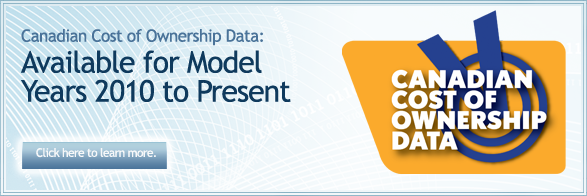
To calculate cost-of-ownership for Canadian vehicles, we measure 8 different cost elements as described below:
- Depreciation: Depreciation is the reduction in value incurred during a given period of time. Vincentric estimates the annual depreciation on each vehicle by identifying the difference between vehicle's estimated market price and the forecasted residual value of the vehicle.
- Fees & Taxes: These administrative fees also add to the cost of owning a vehicle. Vincentric calculates these costs by province for each vehicle in our database. We then use an average by province to create a fees and taxes amount to use for Canada.
- Financing Costs: Financing is the amount it costs to borrow money for a vehicle purchase. The standard Vincentric approach is to assume a 15% down payment with a 5 year loan term, using average finance rates for the geographic territory in which the cost of ownership is being calculated. Users of the Vincentric system can adjust the down payment percentage and finance rates to reflect alternative financing options.
- Fuel Costs: As the starting point for our calculations, Vincentric uses the Natural Resources Canada Office of Energy Efficiency’s estimated mileage figures for both highway (45%) and city (55%) driving. Vincentric will use other industry sources if the OEE information is not yet available. Users of the Vincentric system can adjust the estimated percentage of mileage for these two types of driving. We then incorporate an estimated price for each liter of fuel, with updates compiled monthly by Province using industry sources that track up-to-date fuel prices. Because we are estimating long term fuel expenses, we use a 5-month weighted average for fuel prices with a heavier weighting on the most recent months. This is done to eliminate the short term peaks and valleys that are often seen in fuel prices.
- Insurance Costs: Insurance costs vary by type of vehicle, driver, and coverage amounts. Using data from multiple insurance industry sources, Vincentric estimates insurance costs for each vehicle in our database.
- Maintenance Costs: Maintenance costs are impacted by three key elements: Frequency, Labor Rates, and parts prices. Maintenance costs are based upon the manufacturer’s recommended maintenance schedules, with unscheduled maintenance items such as tires and batteries added to determine overall maintenance cost.
- Opportunity Costs: Opportunity Cost refers to the interest earnings that could have been generated using the out-of-pocket expenses spent on the vehicle.
- Repair Costs: Repair costs are estimated using the cost of a $0 deductible extended service contract that covers all repair costs. This approach is the industry standard and provides an accurate way of fairly comparing vehicles to across brands and size classes.